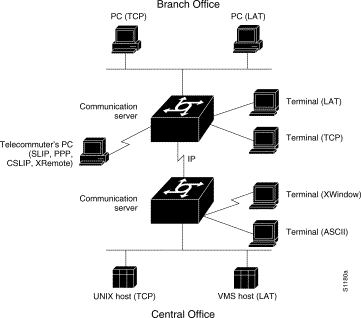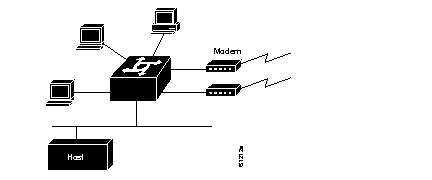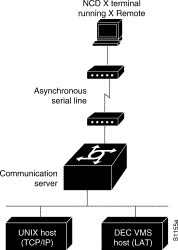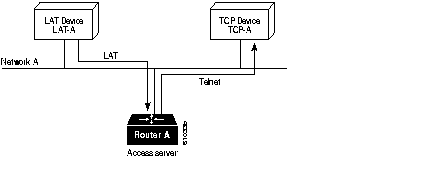|
|

This chapter provides a general description of the connection features supported on your server product (communication server, access server, or router) to connect terminals, modems, microcomputers, and networks to local-area networks (LANs) or wide-area networks (WANs).
A user can dial in and use a port for the following types of connections:
This range of functionality is possible because multiple roles can be assigned to each line. Each line can be a source of data for terminal-server communications (using Telnet, LAT, rlogin, and so forth), for telecommuting (using XRemote and SLIP), or for terminal services or telecommuting using protocol translation.
Following are brief descriptions of the protocols and connection services supported by server products (communication servers, access servers, and routers).
Three types of connection services are available with your server product (see Figure 1-1):

Terminal services provide terminal-to-host connectivity with virtual terminal protocols, including Telnet, LAT, TN3270, and rlogin. Modems can be set up for rotary connections, so that you can connect to the next available modem. A host can also connect directly to a server. In IBM environments, TN3270 enables a standard ASCII terminal to emulate a 3278 terminal and access an IBM host across an IP network. In Digital environments, LAT support provides a terminal with connections to VMS hosts.
On LANs, terminal services support the following types of connections:
Figure 1-2 illustrates terminal-to-host connections.

Using SLIP or PPP, you can run TCP/IP applications, including Telnet, Simple Mail Transfer Protocol (SMTP), and File Transfer Protocol (FTP), over serial lines. You can get remote connectivity with the same functionality as a PC attached to a local network. You can also use the XRemote protocol over asynchronous lines, because the server can provide network functionality to remote X display terminals.
Telecommuting services support WAN connectivity with XRemote, SLIP, and PPP. Other WAN services include X.25, Switched Multimegabit Data Service (SMDS), and Frame Relay. Full IP and IPX routing services are also supported. Communication and access servers are network-compatible with routers, which you can use to extend your network to any size you need.
Figure 1-3 illustrates an XRemote connection using a communication or access server. Refer to the Access and Communication Servers Configuration Guide for additional possible XRemote configurations.

Figure 1-4 illustrates telecommuting connections where remote users dial into a server and connect to network services.

Protocol translation translates virtual terminal protocols so that devices running dissimilar protocols can communicate. Protocol translation on a communication or access server supports Telnet, LAT, and X.25.
There are two ways to make connections using a server set up to support protocol translation:
With the one-step method, you perform bidirectional translation between any of the following protocols:
The two-step method enables connection to IBM hosts from LAT, Telnet, rlogin, and X.25 PAD environments. Users must first connect to the server supporting protocol translation, then use the TN3270 facility to connect to the IBM host. Figure 1-5 illustrates LAT-to-TCP protocol translation.
In general, you use the two-step method when you want temporary use of a server supporting protocol translation as a general-purpose gateway between two types of networks (for example, X.25 PDN and TCP/IP). Instead of configuring the server for every possible connection via embedded translate commands, the two-step method allows you greater flexibility in terms of connecting to network resources accessible via the server supporting protocol translation.

|
|